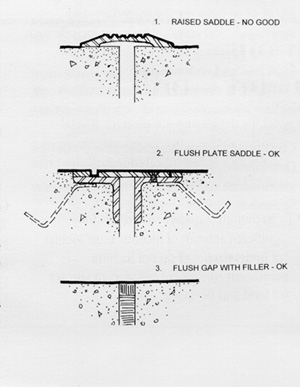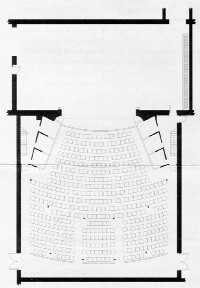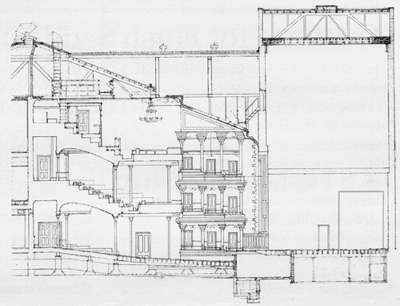
The Who, What, Why and How of Theatre Costs
How much should it cost? How much will it cost? How much can we afford to build? As theatre consultants, we are frequently called upon to answer such questions, especially at the beginning of projects, and often well before the design teams are assembled, space programs are completed, and concept designs are on paper. The following is an introduction to the "who, what, when, where, why and how" of performing arts facility project costing.
WHO? Early cost projection for performing arts projects can be accomplished in several ways. Experience in performing arts facility design and construction is the key ingredient to a successful cost projection. A cost analysis can be prepared by a professional cost consultant, construction cost estimator, quantity surveyor, contractor or a combination of some of the above. Experience in the costing of this building type can be crucial, as unit cost plans for performing arts projects can be vary greatly from unit costs assigned to more conventional design projects. A thorough understanding of the specific structural, mechanical and electrical requirements for performing arts buildings is critical to the preparation of a good cost estimate, especially during the early phases of the design. Furthermore, a qualified cost estimator- particularly one experienced in performing arts facilities- will fully understand the factoring in of enhanced circulation requirements, acoustical demands, specialized wall constructions, and critical adjacencies, all of which will affect the costing of the project. A contractor or construction manager, however competent, rarely has sufficient information well in advance of the design process on which to base a reliable and accurate projection.
WHAT? A cost plan or cost model will identify the elements that constitute the overall project cost. The project cost will include not only the cost of constructing the building, but also additional costs such as performance equipment costs; theatre seating; costs for fixtures, furnishings, and equipment (FF&E); contingencies; escalation indexes; professional fees; and site preparation and landscaping. On top of all of these are the legendary- and significant- "soft costs," which can include such items as financing costs, fundraising costs, legal fees, and endowments.
WHEN? A comprehensive cost analysis can include a project costing at each phase of the design process including Programming, Conceptual Design, Schematic Design, Design Development and Contract Documents. Intermediate cost exercises within phases may be necessary to determine the impact of specific design choices. But no costs analysis has as much impact as the initial cost projection, which will determine the overall scope of the project. This initial projection is usually based on an architectural program, which lists all anticipated spaces in the facility, as well as suggesting the level of theatrical equipment and acoustical criteria for each performance space. The architectural program is often prepared by the theatre consultant or by an architect experienced in theatre design, and is usually prepared after a significant amount of input from the users and potential users of the facility.
WHERE? The location of the project is a significant factor in the preparation of a cost estimate. Labor and material costs can change dramatically depending on local and regional construction environments. Transportation charges, local and state taxes, labor regulations and construction conditions are related to location. Construction cost indexes and contractor surveys are often used by cost consultants and estimators to determine local cost conditions.
WHY? The primary purpose of the initial cost projection is to help determine the feasibility of the project; project costs are compared against potential funding capability. The primary purpose of a project cost estimate is to bring together the project scope and the project budget, Once quality levels have been agreed among the owner, architect and design team, the project should proceed through each design phase only when the program and the budget are reconciled.
HOW? Cost estimates can be prepared at each phase of the project, employing varying techniques to compensate for the continuing evolution of the design. Estimates can be prepared at the beginning of a project based solely on an assignment of square footage and an agreed assumption of the level of quality. In the early phases, cost estimates will carry large design and construction contingencies. These contingencies become progressively absorbed into the elemental cost projections as the design becomes more fully developed. The choice of grossing factor is a critical ingredient in the preparation of a cost analysis. Performing arts building projects routinely require higher net-to-gross factors that more conventional building design projects. Overall grossing multipliers for these projects are often in the range of 1.5 to 1.7, compared to grossing factors of 1.2 to 1.3 that are found in many residential and commercial projects.
Cost per square foot allowance can vary widely depending on quality assumptions and local and regional construction indexes. Overall project per square foot costs can easily range from around $200 per gross square foot to more than $400 per gross square foot, depending on the quality aspirations of the owner and the project designers. Project costs are also affected by the amount of support space included in a performing arts facility. The lobby, auditorium, and stage carry by far the most expensive construction costs, while support spaces such as dressing rooms and storage rooms represent relatively low construction costs. Therefore, projects with minimal support space will likely have higher construction costs on a total per-square-foot basis.
Technique for preparing accurate cost projections can vary greatly. A method that has been successfully employed on larger projects is the reconciliation process involving a qualified cost consultant and a construction manager. In this technique, the two parties independently prepare their cost projections. The design process proceeds to the next phase only when the cost consultant and the construction manager together reconcile their individual cost estimates.
SUMMARY
Methods of projecting and estimating costs can vary greatly- from the theatre consultant's preliminary estimates based on rules-of-thumb, to comprehensive estimates prepared by the professional cost consultants. An understanding of the cost parameters of a project from the outset of the design process and a continual cost monitoring of the project will help to keep the project on track and to avoid as much as possible any last minute budget surprises.
The Case for Flush Saddles in Theatres
In buildings other than theatres, the standard transition between floors of different materials is a raised saddle. Raised saddles are also used at some doors and expansion joints. Usually the saddle is a metal bridge- often an aluminum extrusion- that sits over the joint between adjacent floor materials. Occasionally saddles are made of other materials, such as wood or marble. Raised saddles stick up a fraction of an inch above the floor surfaces on either side. This standard raised saddle details is unsuitable for any location in a theatre where pianos, wardrobe racks, scenery, road boxes, and other units on casters are rolled in and out. For example a change of floor materials is often needed between the stage and the corridor, and again between the corridor and the scene shop. An architect might normally detail each change of material with a raised saddle. In locations in a theatre where rolling equipment is used raised saddles should not be used.
saddle. Raised saddles are also used at some doors and expansion joints. Usually the saddle is a metal bridge- often an aluminum extrusion- that sits over the joint between adjacent floor materials. Occasionally saddles are made of other materials, such as wood or marble. Raised saddles stick up a fraction of an inch above the floor surfaces on either side. This standard raised saddle details is unsuitable for any location in a theatre where pianos, wardrobe racks, scenery, road boxes, and other units on casters are rolled in and out. For example a change of floor materials is often needed between the stage and the corridor, and again between the corridor and the scene shop. An architect might normally detail each change of material with a raised saddle. In locations in a theatre where rolling equipment is used raised saddles should not be used.
Raises saddles are unsuitable for two reasons: (1) the increased effort to lift rolling freight over the saddle is a nuisance; and (2) the noise generated when anything rolls over a raised saddle is unacceptable in a performance environment. Almost everything in a theatre moves on relatively small (i.e., 4 inches) casters, and everything should roll over floor joints smoothly, as if nothing was there.
Thre are several alternative details suitable for use in theatres. Among these solutions are a flush hairline joint with no saddle filled with standard joint filler, or steel plate saddle that is recessed flush with the floor. The plate saddles are detailed "heavy duty" as they would be for an industrial environment, which is actually the case.
Joint design is made more complex by three related issues.
1. The wood stage floor expands and contracts as the air humidity changes. The floor needs room to move at joints with adjacent floors.
2. In some theatres the stage house structure is isolated acoustically from the adjacent parts of the facility. High values of acoustical isolation require that the stage is built as a separate structure- in essence it is a separate building. Floor joints at the perimeter of an isolated stage are expansion joints that have acoustical isolation value. Sometimes the acoustical doors align over the saddles, which makes sealing the acoustical doors airtight to the floor very difficult.
3. The stage and adjacent building structures can have different heights, weights, and foundations, leading to differential settlement. When differential settlement occurs the saddles become ramps between adjacent floors at different heights.
At several times during the preparation of the contract documents the design team should review the likely path of rolling equipment in the building. Doorills, expansion joints, acoustical joints, changes of floor material, and all other floor joints in those paths should be checked for appropriate flush joint details. The acoustician and door detailers should be made aware the requirement for flush doorsills.
Springer Opera House, Columbus, Georgia
The Springer Opera House in Columbus, Georgia, was originally built in 1871 and has been designated as the official State Theatre of Georgia. A surprisingly large number of famous performers and lecturers have played the Springer throughout its history. It is now the home of the Springer Theatre Company.
the official State Theatre of Georgia. A surprisingly large number of famous performers and lecturers have played the Springer throughout its history. It is now the home of the Springer Theatre Company.
Although many minor alterations were made to the building over the years, only one major remodeling had been done; that was shortly after the turn of the century. In 1997 a second major remodeling was undertaken. Part of this effort was to expand public rooms into parts of the building that had been closed for many years. These rooms, other existing public spaces, and the audience chamber were restored to their 1912 appearance. The Springer now seats a total of 450 patrons with seat arranged on the main floor, in two tiers of boxes, and the first of two balconies. Code issues prohibit use of the balcony and third tier of boxes as public spaces. The second balcony now houses control booths for lighting an sound, some ante-proscenium lighting equipment, and follow spots.
Acoustical considerations and the size of the orchestras used at the Springer dictated that a new orchestra put be designed for the building. It is planned to include a lift and was fitted into the building in such a way as to appear to be original.
The backstage areas and theatre systems were completely  modernized. Perhaps the most interesting challenge was replacing the original wood grid and hemp rigging system with a modern steel grid and counterweight system. This aspect of the work had to be accomplished without disturbing the gambrel roof and supporting trusses at the top of the fly tower. To accomplish this, a completely new steel structure was erected inside the building, with the gridiron fitted between the bottom chords of the existing trusses. Completely new performance lighting and integrated sound systems were also designed and installed. Because extensive runs of signal wiring were required between the sound control room and the stage, fiber optic technology was used between those locations.
modernized. Perhaps the most interesting challenge was replacing the original wood grid and hemp rigging system with a modern steel grid and counterweight system. This aspect of the work had to be accomplished without disturbing the gambrel roof and supporting trusses at the top of the fly tower. To accomplish this, a completely new steel structure was erected inside the building, with the gridiron fitted between the bottom chords of the existing trusses. Completely new performance lighting and integrated sound systems were also designed and installed. Because extensive runs of signal wiring were required between the sound control room and the stage, fiber optic technology was used between those locations.
The architect was Hecht Burdeshaw Johnson Kidd and Clark of Columbus. Theatre consulting, acoustical work, and theatre systems design was provided by CDAI.
ASTC Tours Minneapolis, Meets with IAAM in Fort Worth
For its summer "Forum 98" the ASTC met in Minneapolis and discussed in depth issues related to the forum's topic, "Planning the Front of House." We were joined in our discussion by Mary McColl, Director of Operations at the Ordway Music Theatre in St. Paul, and Jason Rahn, Theatre Manager for Concordia University, also in St. Paul. The discussion centered on lobbies, box offices, concessions, public restrooms, and other related issues. Among the high points were the following findings:
-
Most theatre lobbies are used for special events and are highly in demand, but most lobbies lack sufficient catering facilities to support such events.
-
Even though concessions account for a significant amount of income, most lobbies are undersized and do not include permanent concession counters or storage for food and beverage.
-
Most patron accidents involved tripping on aisle steps, particularly in balconies. Usually the addition of railings reduces the number of tripping accidents.
ASTC members toured some of the Twin Cities' many theatres, including the Fitzgerald Theatre (formerly World Theatre), the Ordway Music Theatre, and Concordia University, all in St. Paul; and Theatre de la Jeune Lune and Orchestra Hall, both in Minneapolis. The Fitzgerald Theatre is home for "A Prairie Home Companion" radio show and is also used for numerous resident and touring performing arts events. The Ordway Music Theatre is home for the Minnesota Opera and also hosts many touring events. Theatre de la Jeune Lune is a large "black box" theatre fashioned out of an old storage warehouse by a very successful experimental theatre company.
This winter, the ASTC met in Fort Worth in conjunction with the International Association of Assembly Managers (IAAM) Performing Arts Conference, and the ASTC presented two panel discussions, one led by Duane Wilson and one led by Steven Friedlander. The ASTC also hosted a very successful theatre design charette with members of IAAM and ASTC participating.
The 1999 ASTC Forum will be held in San Francisco on July 30 and 31 and August 1, and will focus on Opera House Design. The 2000 ASTC Annual Meeting will be held in New York City and will include tours of the New Jersey Performing Arts Center and the New Amsterdam Theatre.
Other ASTC News
The ASTC continued its formidable presence in the formulation of building codes with the participation of Bill Conner, Eugene Leitermann, and Duane Wilson at the most recent public hearings on the first edition of the International Building Code (IBC) to testify on many proposals affecting the design and operation of theatres. ASTC prevailed in gaining approval of the vast majority of proposals submitted, most of which were based on the BCMC report on Stages and Platforms. While the mission of revising and modernizing the codes for theatres will continue, succeeding in these changed to the 2000IBC is an achievement ASTC and those manufacturers who supported out BCMC work can be proud of.
Two new ASTC members have been accepted: Josephine Marquez and Lawrence L. Graham.
William B. Allison III has been named an Associate at Artec Consultants, Inc., and Michael J. Mell has been named Director of Artec's Theatre Consulting department.
William Conner has joined the Chicago office of Schuler & Shook, Inc. as a theatre project manager.
Both San Francisco and New York offices of Auerbach + Associates have recently moved to new addresses:
Auerbach + Associates
225 Green Street
San Francisco, CA 94111
Tel. 415-392-7528
Fax. 415-392-7530
Auerbach + Associates
49 West 38th Street - 12th Floor
New York, New York 10018-5509
Tel. 212-764-5630
Fax. 212-764-5632
New officers of the society were elected in February in Fort Worth, and they are:
Robert Long, President
Jack P. Hagler, Vice President
Edgar L. Lustig, Secretary-Treasurer
S. Leonard Auerbach, Director
Todd Hensley, Director